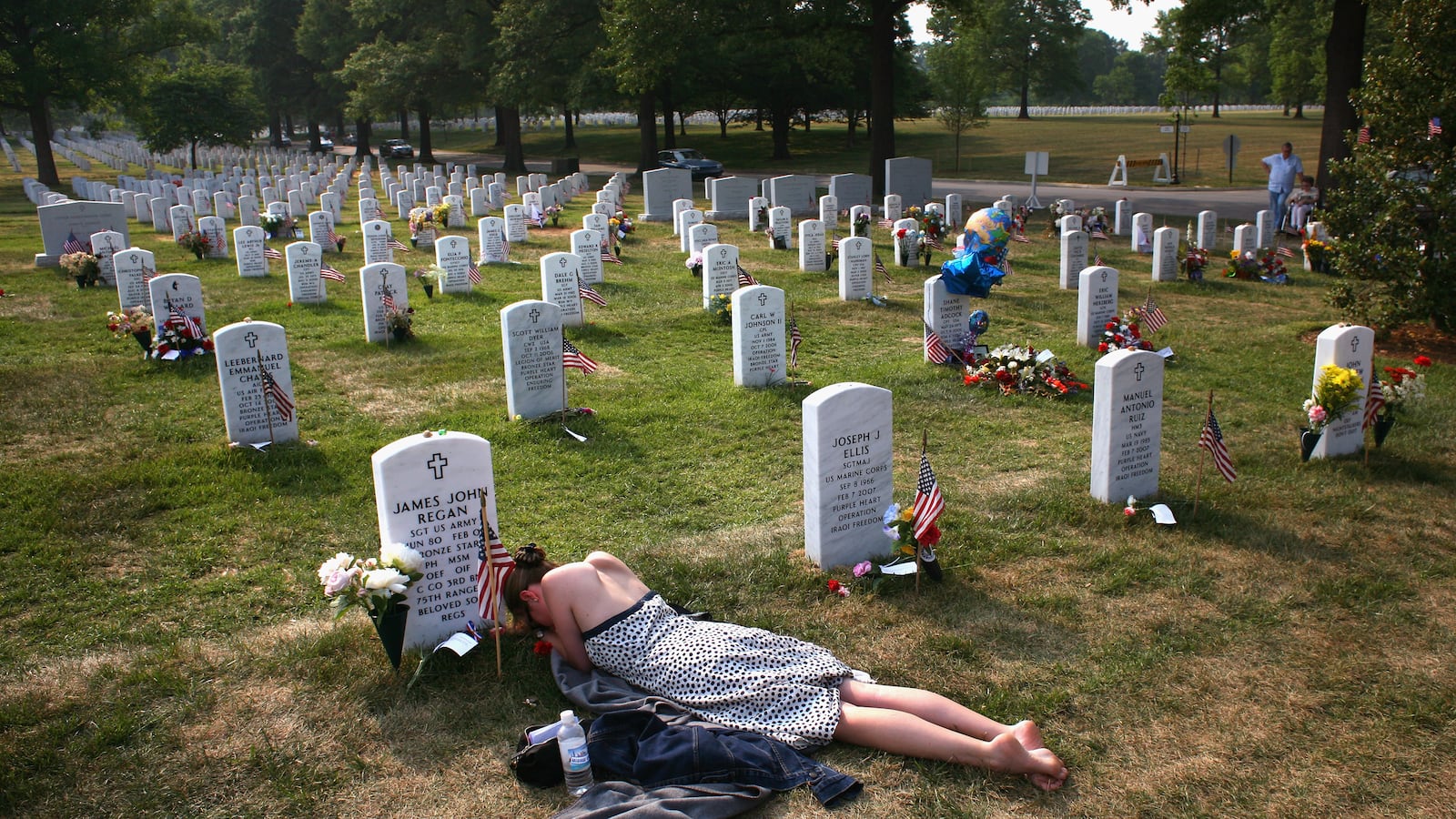
“Photographs of an atrocity may give rise to opposing responses: a call for peace; a cry for revenge; or simply the bemused awareness, continually restocked by photographic information, that terrible things happen.” Susan Sontag, “Looking at War: Photography’s View of Devastation and Death,” New Yorker, December 9, 2002.
The toll of war continues long after the last battle is fought. Mary McHugh, visiting the grave of her slain fiancé, Sgt. James Regan, on the first Memorial Day weekend after his death in 2007, is directly involved in the harsh reality of combat. While the violence and physical danger of the battleground are far away from this frame, Mary is a casualty suffering the direct and utterly unexplainable trauma of losing a loved one. Though this image cannot communicate the reality of such a loss, it reframes the manner in which war is seen and consumed through a carnal yet depressingly familiar barrage of smoldering ruins, bloodied victims, and brave soldiers. There is neither condemnation of nor justification to combat; only an evocation of the incalculable sadness marked with every tombstone.
John Moore/Getty
The enemy of my enemy is my friend; over the past 10 years, U.S. troops and insurgents have shared power in a delicate balance as both parties attempt to create a new normalcy. The Iraqi Sunni fighter on the left shares a video on his mobile phone with a U.S. soldier from Second Squadron First Cavalry Regiment, in the restive Diyala province, located northeast of Baghdad. It’s a jovial moment between men from opposite sides of the world for sure, but for me this moment from March 11, 2008, is about so much more. Nearly an entire generation knows only an Iraq with a U.S. presence, and while we officially left in 2011, anger and resentment still linger. The question remains, what will be the future Iraq and U.S. relationship now that the country has been returned to the Iraqis?
David Furst/AFP/Getty

When President Obama was elected in 2008, many expected his administration to accelerate our exit from Iraq, but it wasn’t easy to leave as quickly as many voters had hoped. Here the closed captioning of Obama’s primetime television address scrolls over his eyes on a TV screen at the Mayflower Hotel on August 31, 2010, in Washington, D.C. The president formally declared an end to the combat mission in Iraq, saying that after seven years of a war that claimed more than 4,400 American lives, it was time to focus on the war in Afghanistan and on pressing problems at home. The last soldiers would not leave Iraq until December 2011.

Over the past 10 years, a press embargo kept journalists from documenting the caskets of soldiers returning from the war. The Bush administration, for reasons it never publicly articulated, was most likely practicing a lesson learned from Vietnam. There, photojournalists were given free rein to move about the country, and they published raw and horrific images of the war that helped turn the American public against it. The sanitization of the toll of war from the media landscape was slowly removed under the Obama administration, and we were able to recognize Army Specialist Jamal M. Rhett as more than just a number. Rhett, of Palmyra, New Jersey, was assigned to the First Battalion, 21st Infantry Regiment, Second Brigade Combat Team, 25th Infantry Division, and died on August 15, 2010, in Baqubah, Iraq, of wounds suffered when insurgents attacked his vehicle with grenades.
Chip Somodevilla/Getty
An Iraqi boy looks up at a U.S. soldier during a joint air assault with Iraqi soldiers in Al-Radwaniyah, on the southwest edge of Baghdad, on May 2, 2008. It’s a simple moment amid the chaos, captured by AFP photographer Mauricio Lima, that to me underscores the compassion and suspicion, among other sentiments, that tinge the relationship between the two countries.
Mauricio Lima/AFP/Getty
In one of the last images from the war, taken by Getty Images photographer Mario Tama, soldiers from the Third Brigade, First Cavalry Division board a C-17 transport plane to depart from Iraq at Camp Adder, the last remaining American base, on December 17, 2011, near Nasiriyah, Iraq. I kept coming back to this image because, while it may not be the most stunning or interesting shot from the collection, they are going home. That is why it’s my favorite.
Mario Tama/AFP/Getty
While it was not taken by a professional photographer, for me this image from Abu Ghraib prison is one of the most alarming photographs of the war. Leaked to the press, it shows an unidentified detainee from late 2003 standing on a box with a bag on his head and wires attached to him. It was later revealed that many more such photos had been taken by soldiers, and as the public started to ask questions about why the picture was taken, the revelation that there were more photos proved as shocking as the first image. This series of images depicted a level of inhumanity and cruelty that resonated around the world.
AP
Getty photographer Chris Hondros found a single shaft of light in the violent neighborhood of Gazaliyah on February 8, 2007. The photo illuminates the mix of stress and worry of unpredicable violence on individual psyches of soliders. In this frame, an Iraqi Army soldier smokes a cigarette while on patrol with American forces in the violent neighborhood of Gazaliyah, Baghdad. Snipers are a daily problem for U.S. and Iraqi Army soldiers who patrol the neighborhood, which is beset with Sunni-Shia sectarian violence.
Chris Hondros/Getty




